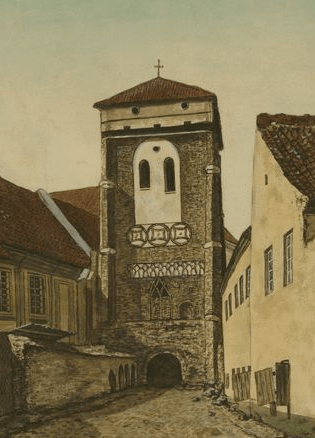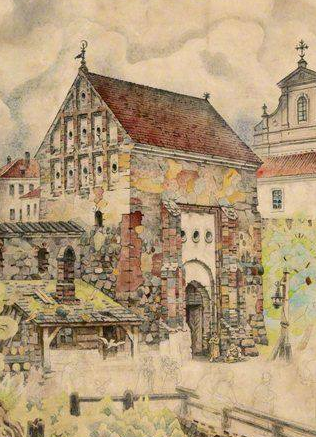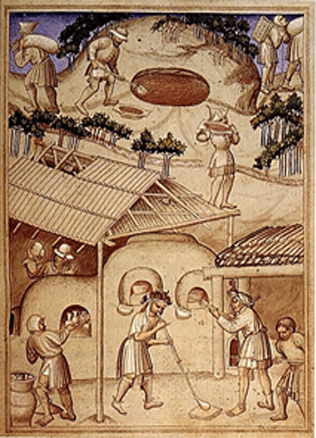The Last Ruler in Vilnius: Alexander Jagiellon
1492 is considered to be a turning point in the history of Europe. Christopher Columbus’ journey and the discovery of America opened up new horizons of space for Europeans, while from this point one should perhaps talk of European history as a part of world history. The Reconquista, came to an end in Spain in 1492, which pushed the Muslims out of the Iberian Peninsula once and for all. This was the final event of a period in history that greatly impacted the development of Europe of the Middle Ages. Christian Europe took on geographic contours that have not change up to the present day. In Europe’s eastern periphery, the Grand Duchy of Lithuania, important events were unfolded in 1492. After a long period of 52 years of rule, King of Poland and Grand Duke of Lithuania Casimir IV died in Grodno in June. The long and successful rule of his rather was a big part of the entrenchment of the House of Jagiellon in Poland and the GDL, and that ensured the handing over of both thrones to his sons. Albert became the King of Poland, and his younger son Alexander became the ruler of Lithuania. What’s more on the occasion of the election of their ruler, the Council of Lords of the GDL gathered in Vilnius for the first time, which was called according to a new principle of having representatives there from each territorial unit. It was the beginning of parliamentary traditions in Lithuania.
A destined name
Do You Know?
Casimir Jagiellon’s sons Alexander (the Grand Duke of Lithuania) and Albert (the King of Poland) were the first Jagiellons that were able to read and write. However, they were the first Jagiellons that did not know Lithuanian.
Alexander was born in the family of Casimir Jagiellon and Elisabeth Habsburg of Hungary. He was the fourth son in their large family. The name was most likely picked in the memory of Vytautas Alexander, who was venerated in the family. The inheriting of this symbolic name later would impact the self-awareness of Alexander as the ruler of Lithuania. His parents took care to give their children a good education. They were taught by two intellectuals of their Krakow estate – historian Jan Długosz and Italian humanist Filippo Buonaccorsi Callimacco. Casimir’s sons were the first of the Jagiellonians that knew how to read and write. At the same time, they were the first of the Jagiellonians that didn’t know Lithuanian. The Lithuanian grand duke most likely did not have a deep knowledge of literary Latin, however Alexander’s upbringing taught him to employ educated people around him and value their advice. And he needed advice, as from the beginning of his rule, he came up against serious challenges. The year 1492 marked the beginning of a new period of history in for the GDL. After Casimir’s death, the Muscovite army invaded GDL territory, which led to the beginning of a long war with the Grand Duchy of Moscow, which not only heavily depleted the GDL’s resources, but within a few decades took away a good fourth of the GDL’s territory. This war heavily influenced a number of important events in Lithuanian history, the first and foremost being the Union of Lublin. The war wasn’t stopped even by political considerations made by Alexander’s marriage to Helena, the daughter of Ivan III Vasilyevich, the Grand Prince of Moscow.
The revitalised pulse of the capital
However, another aspect of Alexander’s rule is more important for Lithuanian history. For the first time in almost half a century, a ruler once again lived in Lithuania. The reforms that accompanied Alexander’s rule showed how much the regular residency of the ruler for a medieval state. New political projects were contemplated and realized in the reconstructed palace of the grand duke in Vilnius. Alexander’s itineraries (the reconstructed route of trips made by historians) bear witness to the fact that he declined the tradition of his predecessors to rule the country while travelling through it, and spent a majority of his time in the centre of the country, Vilnius.
The establishment of a manor for the ruler turned the city into a true capital, which had the main attribute that befitted a capital, which were permanent administrative institutions.
Alexander did his best to give his primary place of residence the necessary aura: already from the beginning of his rule, he adopted the Magdeburg Laws for the city, supported Vilnius’ city dwellers by giving them the right of stowage, and limited the free trade of foreign merchants in the city. 1495 saw the establishment of the first GDL guild (of goldsmiths), which was located in Vilnius. Even more important for the city were the investments and income that the grand palace gave out. The ruler’s palace brought the land’s political elite to the city, which is why in Alexander’s times the nobility was settling in Vilnius more and more. In 1503 they began to build the Vilnius city wall. Today we can see parts that have survived including the Gothic Bernardine Church of Vilnius, the architects of which were invited personally from Gdansk by Alexander. It could be that St. Anne’s Church rose up alongside it around the same time.
Innovation at the ruler’s chancellery
The system of the rule of the state changed. A group of educated secretaries and advisors was gathered at the palace of the grand duke to improve the order of the copying and storing of the documents produced by the ruler’s chancery. This allowed for a more or less reliable order for the preparation and supervision of documentation.
A census was begun for holdings, a conscript army, and the palace’s revenues and expenditure, along with the systematizing of military and treasury data.
The documents devoted to the internal affairs of the state grew, along with the volume of diplomatic correspondence with foreign countries. The specialization of scribes and diplomats sped up, and a new state archive was developed, which is known as the Lithuanian Metrica. This group of advisors introduced new standards in various fields of the life of the state. The head of the Latin section of the chancery, Alexander’s trusted Pole Erasmus Ciołek prepared a speech for the legation in Rome, which became an example for the GDL’s developing diplomacy as well as publicist writing of a political and polemic nature. Earlier at the ruler’s palace, he started the first receipt book in the history of Lithuania, which helped to regulate the ruler’s finances, which up until that time had been organized in a chaotic manner.
New winds in the life of the state
With a constant lack of money, economic policy (especially that of coins) began to come to life. In 1495, a permanent mint began operating in Vilnius. Already during the first year of Alexander’s rule, Lithuanian half groats together with denars became a new phenomenon in the GDL’s monetary policy. New trends could be observed in urban development. Where up until the end of the 15th century, it was only the nobility and cities that were generally at the centre of the country that received privileges of self-rule, then during the times of Alexander, a network of towns and cities having the right of self-rule was formed (especially where the conditions for trade were the best, in areas like Podlasie, Black Ruthenia and lands that are today in Ukraine). The organization of the land’s military changed during the wars with Moscow. At the turn of the 16th century, duty of a permanent military leader called a field hetman appeared. There was another military development that was in line with European trends, which was the appearance of a hired army.
Alexander died in Vilnius on August 19th, 1506. The wish in his will to be buried in the Wawel next to the graves of his brother, father and grandfather, who had served as rulers, were not fulfilled.
Aleksandras was the only member of the ruling Jagiellonian house that was buried in the Cathedral in Vilnius.
Th headstrong decision made by the Lithuanian nobles symbolizes Aleksandras’ place in history of the GDL and of Vilnius: despite the short residency of Sigismund Augustus (while his father was still alive), it was the last period where the Lithuanian capital could be called the residency of a ruler.
Literature: Lietuvos didysis kunigaikštis Aleksandras ir jo epocha, sud. D. Steponavičienė, Vilnius, 2007.
Rimvydas Petrauskas



